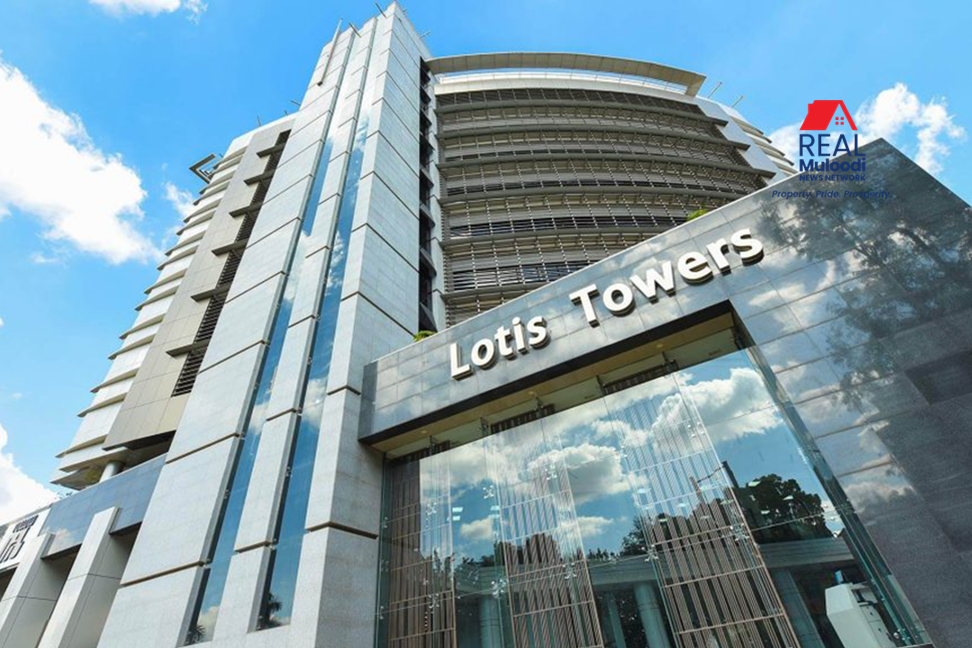UGANDA, Kampala | Real Muloodi News | The National Building Review Board (NBRB) has ordered the evacuation of occupants from a 14-level office block known as Lotis Towers on Mackinnon Road, Kampala, due to concerns about the structural integrity of the building.
After being alerted of the defects in the structure, NBRB sent a team of engineers to visit the site on Tuesday, August 16, to conduct a preliminary assessment.
The NBRB engineers discovered a compression failure of a reinforced concrete column on the 6th Floor of the modern office facility. Several columns with similar signs of failure were observed in the basement.
NBRB has recommended the evacuation of the building for the safety of the occupants and the neighbourhood, while a comprehensive structural integrity assessment of the entire building is conducted to inform the next actions to be taken.


Lotis Towers houses several government offices in the 14-storey building, including the Judicial Service Commission. While some offices have self-evacuated, others are still operating.
Roko Construction Co. Ltd completed the construction of Lotis Towers in 2019.
Response from the Building Owner
Unfortunately, the owner of LOTIS Towers seemed to have downplayed the urgency of the matter stating in a notice that “The column on the 6th Floor had a minor crack. Our structural engineers have examined the crack and their opinion is the building is safe for occupation. In the meantime, ROKO Construction is ready onsite to repair the crack.”
“Management gives the greatest assurance to all tenants and stake holders of the structural integrity of the building and encourages all to continue enjoying our facilities,” added Lotis Towers Management.

NBRB responded, “While the management of the building presented an occupation permit (a document issued clearing a building for fitness of use), several columns with similar signs of failure were observed in the basement.”
NBRB officials have also confirmed that Roko Construction is attempting to remedy the defects, however, they have recommended Kampala Capital City Authority (KCCA) Building Committee review and approve Roko’s remedial methodology.
“While the Project Consultants and Contractor, Roko Construction Co. Ltd studied the defects and are attempting to rectify the anomaly, NBRB has instructed that the proposed remedial work methodology be submitted to KCCA Building Committee for review and approval,” NBRB announced on Twitter.
Response from the Public
One person on Twitter named Martin commented, “I think the remedial work methodology submission may consume time yet this is an emergency.”
Another commentator named Faisal Kawuma added, “I’m curious as to how they were able to maintain an occupancy permit with all that going on.”
Mr Joseph Okello says, “Work was given to a contractor running bankrupt. They compromised structure integrity to financially keep afloat.”
Many are waiting eagerly for the findings from the NBRB as to what has caused the cracks in such a new building and what their next course of action would be.
Addressing the Issue of Dangerous Buildings
The recent series of falling buildings in Kampala has taken many lives and left many others with lifelong injuries, but people should be aware that there are multiple authorities in charge of planning and ensuring constructions meet legal criteria.
Property developers intending to raise structures within Kampala must first apply for development approval and acquire a development authorisation certificate, according to new rules released by Mr Vincent Byendaimira, commissioner at the Ministry of Housing and Urban Development early this year.
“This certificate shall bear conditions that the development must comply with, including, but not limited to, expected parking provision, building height limitations, and permitted land use,” Mr Byendaimira says.
The Kampala Capital City Authority, KCCA Act mandates that property developers fill out an application for approval of plans which is reviewed by the Metropolitan Physical Planning Authority.
Where an owner of a building deviates from an approved plan, drawing or diagram to a substantial degree in terms of plot coverage, height, depth, other dimensions, or structural system or becomes non-compliant with the regulations, the KCCA Building Committee may revoke the building permit for the building operations and require the owner of the building to demolish and remove the building within a specified time at his or her own cost.
NBRB is a corporate body working under the Ministry of Works and Transport, established by the Building Control Act, 2013, to monitor building developments and ensure that the design and construction of buildings and utilities to which the public is to have access are safe for occupation.
READ MORE LIKE THIS:
Physical Planning: Strict New Requirements Laid Out for Property Developers



